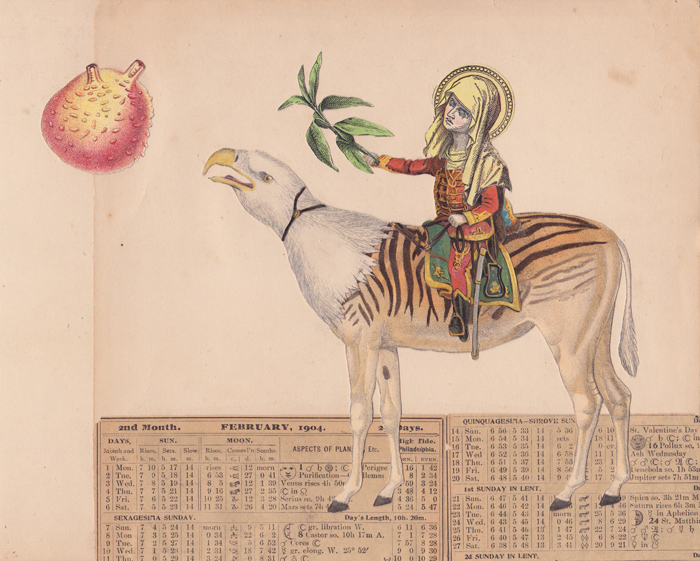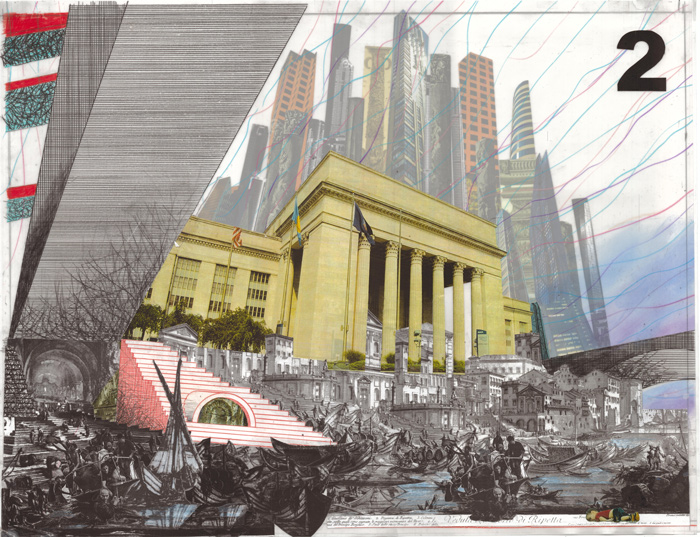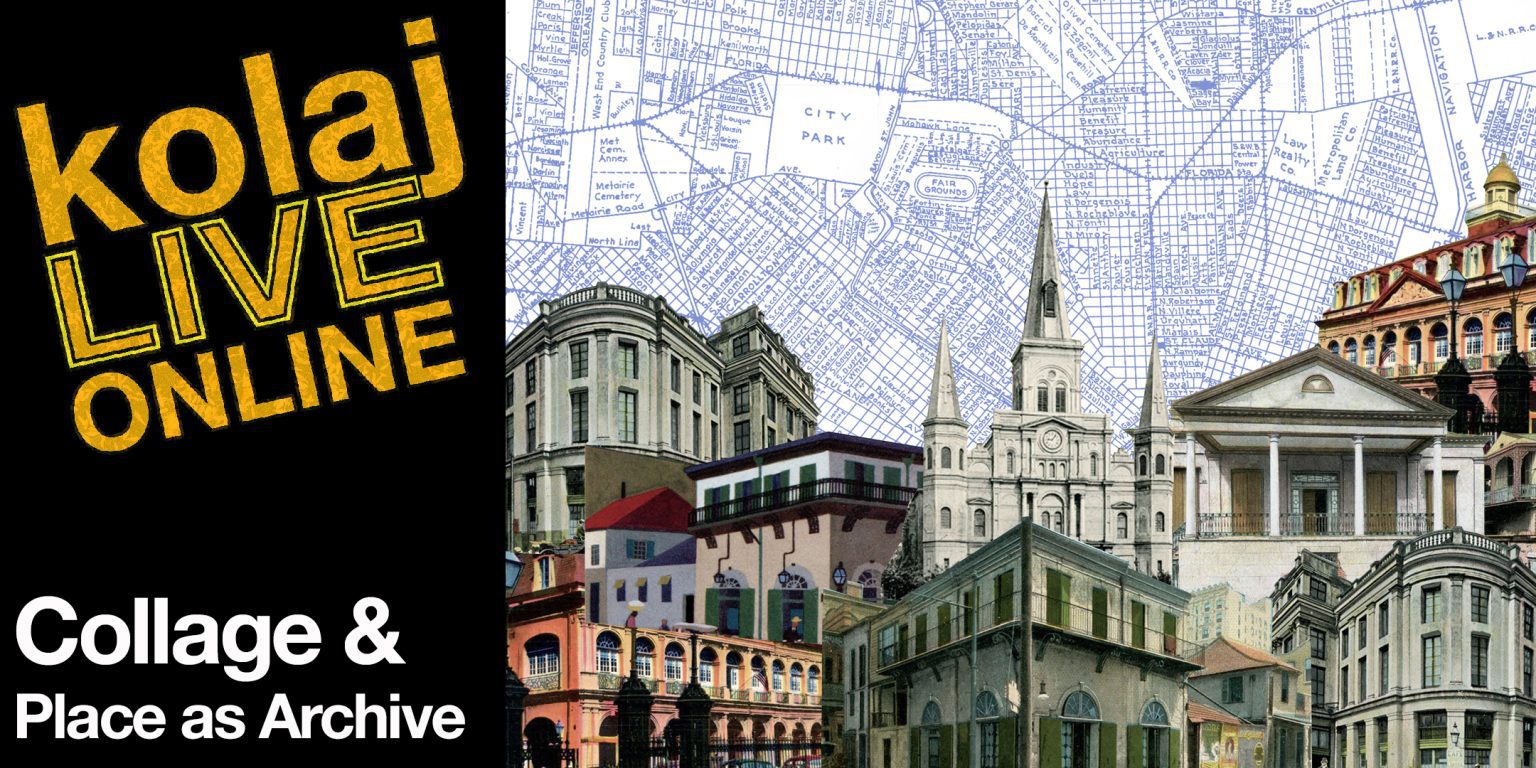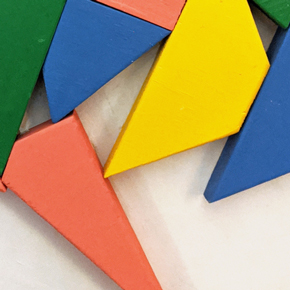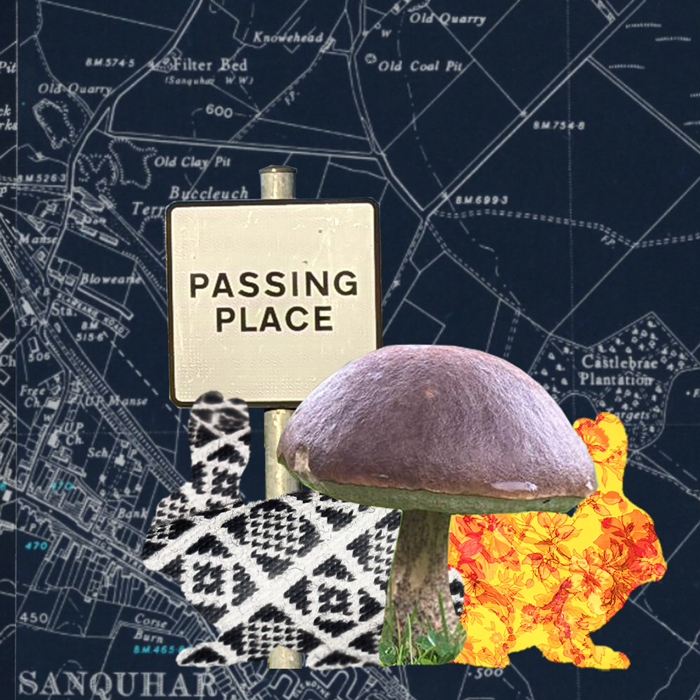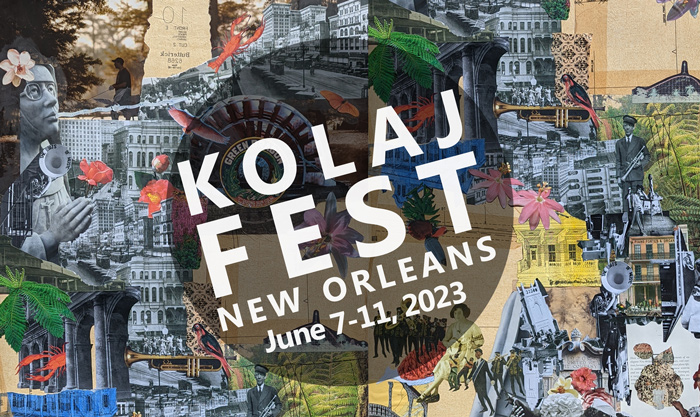![]()
MAGAZINE | INSTITUTE | CURRENT ISSUE | ARTIST DIRECTORY | SHOP
CALLS TO ARTISTS
FROM THE ARTIST DIRECTORY
A Sense of Wonder and Reverie
Denver, Colorado, USA. Brian Barker's influences range from tarot cards and Hieronymus Bosch; to fraternal organization iconography and Renaissance portraiture; to the Mughal paintings of the 16th-18th centuries and the monsters of Medieval marginalia. His collages are often populated by chimera, misfit saints, wayward travelers, and other apocryphal figures. These darkly whimsical beings wander in from the worlds of myths and fables, dreams and nightmares, and the before and after life. He hopes my collages spark for the viewer a sense of wonder and reverie, creating a space to consider such underlying concerns as death, power, time, silence, uncertainty, fear and anxiety, and the relationship between the human and animal worlds. MORE
FROM THE ARTIST DIRECTORY
New Designs/Old Settings
Elkins Park, Pennsylvania, USA. For John James Pron, as an architect and teacher, it is equally important that the beauty of design simultaneously solve the problems and challenges of a society. And so, his art always has a social dimension–if not to actually solve problems, then to make idealistic proposals or, at the very least, to raise awareness of existing problems. Pron's particular niche in the world of collage is the layering of his own architectural proposals into the photographs and lithographs of an existing setting. New designs/old settings. MORE
FROM THE PRINT MAGAZINE
Subliminal Collage
In Kolaj 36, Jane Laster-Gordon reflects on how her collage series “Gotham City” became an accidental reflection on 9/11 Terrorist Attacks in New York City. “On September 11, 2001, I took an early flight from Toronto to New York. At the exact time the first of the World Trade Center towers was struck, I was in the air and my plane was preparing to land at LaGuardia Airport,” she writes. "Years after the fact, I have become aware it must have been subconsciously on my mind as I created the collages from my Dad’s photo of the New York skyline."
MORE
KOLAJ LIVE ONLINE
Artists in the Archives:
Collage & Place As Archive
Wednesday, 11 January 2023, 7PM EST. Thinking of place as an archive is fertile terrain for collage artists who seek to incorporate a sense of place into their practice. During this Kolaj LIVE Online event, panelists will present artwork and discuss what it means to explore a place through the collage artist lens. Brooklyn-based artists S. Erin Batiste and Aisha Shillingford will speak about how their experience of the Collage Artist Lab: City as Archive in New Orleans in November 2022 informed the artwork they are making about the city. They will be joined by Denver-based artist Jennifer Evans and Vancouver-based artist Aimee Henny Brown who will speak to their experience bringing the history and folklore of Sanquhar, Scotland into their artwork. The panel will be led by Ric Kasini Kadour who will speak about how Artists in the Archives at the Henry Sheldon Museum is an example of collage artists engaged with place and Kolaj Institute's 2023 initiatives that bring together artists to explore place and make art that uses history and folklore to speak to communities. MORE
COLLAGE COMMUNITIES
Collage Working Club
Based in Lisbon, Portugal, Collage Working Club is a weekly open workspace for artists working in the medium of paper. Organized in the format of alternate "drop in" sessions and workshop masterclasses, it has both a regular facilitator, whilst also involving the artist community in the sharing of knowledge and skills. The group is hosted by collage artist Nina Fraser and occupies the physical space of Art&Craft Refúgio, part of Residências Refúgio and Largo Residências. MORE
FROM THE PRINT MAGAZINE
Evelyn Rapin
Kingston, Ontario, Canada. Many collagists who use fragments as paint see elements as pieces of color which, when built up, compose a picture. Evelyn Rapin takes this a step further and uses fragments to layer deeper meaning into her collage. Her work is an example of how collagists use the medium to move from picture making to meaning making. She writes, "Although my art is always driven by a particular idea, I still rely on chance and accident during the process and this approach leads to an expressive and interesting outcome." A portfolio of her artwork appears in Kolaj 36. MORE
CALLS TO ARTISTS
CURATING COLLAGE
WORKSHOP
Deadline: 28 December 2022
LEARN MORE
COLLAGE ARTISTS RESIDENCY:
SCOTLAND
Early Deadline: 30 December 2022
LEARN MORE
Kolaj Fest New Orleans Call for Papers, Artists & Projects
Deadline is Sunday, 29 January 2023.
LEARN MORE
NEW BOOK
NEW BOOK
PoetryXCollage
Volume Three
PoetryXCollage is a printed journal of artwork and writing which operates at the intersection of poetry and collage. Each issue presents six movements of work by artists and curators. Page spreads are meant to be free zones of thinking where the contributor has chosen all elements of the layout: font, image place, composition, etc. In Volume Three: Adam Farcus (Urbana, Illinois, USA) | Carolina Martins (Lisbon, Portugal) | Émilie Karuna (Montreal, Quebec, Canada) | Jenn Arras (Brooklyn, New York, USA) | Julie Byers (Coffs Harbour, New South Wales, Australia) | Kerrie More (Kalispell, Montana, USA).
PRINT MAGAZINE
Kolaj Magazine relies on our subscribers. Your support of this magazine keeps us going and makes it possible for us to investigate and document collage and to promote a deeper, more complex understanding of the medium and its role in art history and contemporary art.
NEW ISSUE
Kolaj #36
Barbara Bertino's Sailing the Dry Land graces the front cover of Kolaj 36 which we think is an apt metaphor for a print magazine where each issue travels around the world of collage. In the print magazine, we travel from the western foothills of the Sierra Nevada to Rio de Janeiro to Kampala, Uganda to report on the international community of collage artists and what this 21st century art movement is doing. Kelli Bodle takes us back in time to explore the legacy of Italian Proto-Arte Povera Artist Salvatore Meo. We hear from a collective of composers in Peru (all of whom are women) who are making collage heard as well as seen. We get an update on how the U.S. Supreme Court may be changing Fair Use. And we consider the painterly influences and attitudes of collage artists, whether two-bit collage is a sort of minimalism, and how one artist came to love collage in motion. We hope each issue of Kolaj Magazine takes you someplace you've never been. MORE
RECENT PUBLICATIONS

NEW BOOK
Wallflowers: Collage as Street Art
Wallflowers: Collage as Street Art explores the intersection of collage and street art. Christopher Kurts recalls the formation of the Kolaj Street Krewe from its creation at Kolaj Fest New Orleans to a guerilla art project during the COVID-19 pandemic to an artist residency for Street Artists. The book contains examples of collage as street art by twenty-four artists from eight countries. MORE
BOOK
Artists in the Archives
Local history museums, archives, and collections are vital to building healthy communities and to anchoring our understanding of the world around us in the place where we live, work, and play. Collage artists have unique skills that are particularly useful in our historical moment. Artists in the Archives contains artworks and commentary as well as an extensive essay by Ric Kasini Kadour about the project that brought twenty-three artists from seven countries to make twenty-four collage prints referencing history material in the archives of the Henry Sheldon Museum. The essay reflects on the role artists can play in the interpretation and presentation of historic material in light of this history. MORE
BOOK
Politics in Collage
In a time where the challenges facing us as individuals and communities have grown to seemingly insurmountable levels, further exacerbated by the increasing toxicity of the political climate, artists are using their work to confront these challenges by engaging their viewers in a higher level of discourse. Through a virtual residency, twenty-five artists created collage works examining complex socio-political issues that contemporary society is contending with, in order to spark meaningful dialogue and inspire deeper engagement. MORE
BOOK
Empty Columns Are a Place to Dream
A companion book to the project of the same name, Ric Kasini Kadour unpacks what monuments are and their role in our communities. The book shows what happens when collage artists reimagine monuments as sites of truth and reconciliation. The book features the collages of eighteen international artists made a series of collages that reimagined the empty column in the center of Birr, County Offaly, Ireland. MORE
BOOK
The Money $how: Cash, Labor, Capitalism & Collage
The Money $how juxtaposes contemporary artwork against fragments of history and literature as a way of showing how collage can help us deconstruct culture and understand the world differently. Artists collage dollar bills into flowers and mine material remnants to tell stories about home economics. MORE
BOOK
Radical Reimaginings
The curators of the 96-page book invited artists who use collage in their practice to put forward a work of art that offers a visual narrative that speaks to the unprecedented change unfolding in 2020. An essay by Ric Kasini Kadour reflects upon collage's unique ability to imagine new realities. Forty artists from nine countries and multiple Indigenous peoples—Salish-Kootenai/Métis-Cree/Sho-Ban, Tlingit/Nisga’a, Oglala/Lakota, and Seneca Nation—offer a variety of perspectives. The voices of Black, Latinx, Native, and white Americans mingle with those from Chile, Colombia, Mexico, Peru, Argentina, Canada, France, and Germany. Artwork is accompanied by a statement in which the artists describe how they want to reimagine the world. MORE
BOOK
Collage Magic
by Emma Anna
Part autobiography, part fantasy, Emma Anna’s vision of The New Old World (aka The NOW) fuses vintage ephemera with modern imaging technologies. Emma shapes this strange world by using the pen tool from Adobe Photoshop as her magic wand, in the process declaring herself to be a “collage magician”. Part artist book, part document of art making, Collage Magic, from La Casa Verde Editions, is Emma Anna’s journey through magic and art. MORE
BOOK
Revolutionary Paths
When the collage is presented in exhibition, it is often done so without the critical framework granted other mediums. In "Revolutionary Paths: Critical Issues in Collage", exhibition curator Ric Kasini Kadour presents examples of collage that represent various aspects and takes on the medium. Each work in the exhibition represents the potential for deeper inquiry and further curatorial exploration of the medium. MORE
BOOK
Cultural Deconstructions
Collage is unique as a medium in that it uses as its material artifacts from the world itself. To harvest those fragments, the artist must first deconstruct culture; they must select, cut, and remove the elements they do not wish to use and then reconstruct work that tells a new story. In "Cultural Deconstructions: Critical Issues in Collage", exhibition curator Ric Kasini Kadour presents examples of collage artists who are deconstructing identity as a way to critique culture. MORE
COLLAGE BOOK
Tissue Box:
A Pandemic Response
Boite à mouchoir: Une réponse à la pandémie. In Spring 2020, as the world was going into lockdown due to the COVID-19 pandemic, Quebec Collagiste Virginie Maltais felt a deep need for a point of reference. Her solution was a project that asked collage artists from around the world to make a collage using the top of a tissue box. "Small projects are important. You regain your courage and hope when you start and manage to finish something. There is no small project. We do big projects with lots of little steps. Step by step, we move forward. Together. And it is all of these small steps, together, that led to the creation of this book." Maltais worked with Kolaj Institute and Kasini House to produce a bilingual book about the project. MORE
COLLAGE BOOK
Unfamiliar Vegetables: Variations in Collage
Unfamiliar Vegetables is a collection of collage where each of the fifty artists interpreted, in their own way, Carlotta Bonnecaze’s 1892 Carnival float design Familiar Vegetables. Project organizer Christopher Kurts observed, “Unfamiliar Vegetables is an experiment in controlled chaos….tiny variations within each artist’s creative sphere accumulate until the outcomes are as unique as the people creating them.” MORE
Our goal with every issue is that Kolaj Magazine is essential reading for anyone interested in the role of contemporary collage in art, culture, and society. Each issue of Kolaj Magazine is dedicated to reviewing and surveying contemporary collage with an international perspective. We are interested in collage as a medium, a genre, a community, and a 21st century art movement.
